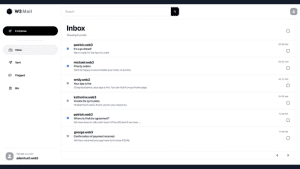The First Email
The history of email has come a long way since Ray Tomilson sent the first ever one in 1971, making him the pioneer of email communication.
Using the “@” symbol to separate user and computer names, he sent a test message between adjacent machines.
Then, during the 80s and 90s, internet mail servers and clients were now being used more by organizations in business, schools, government, and smaller organizations.
Later in 2000, email was better popularized due to the advent of smartphones and computer devices.
Now, it’s 2023 and we are looking at the future of emailing – Web3 Email.
What is Web3 Email Service
Web3 Email service is a concept used to describe email services provided by web3, contrasting the traditional type of email and offering enhanced privacy to users.
The systems used for email services in web3 are tailored to be decentralized and not relying on a central server/authority such as Google, Microsoft or Yahoo.
In traditional email services, your messages and personal information are often stored on centralized servers owned by email providers. This can lead to concerns about data privacy, as these providers have access to your communications.
However, Web3 email services take a different approach.
Imagine a situation where a reporter is working on an investigative story that involves a big story.
To piece together the puzzle, they need to connect with anonymous sources who hold crucial evidence. But with traditional email services that are vulnerable to hacks, the reporter opts for a web3 email service.
With the Web3 email service, the reporter crafts the message in a code that only the intended recipient can decipher. Even if someone tries to steal it, they’ll only get a bunch of mixed-up letters.
The reporter then sends the encrypted message, knowing that it travels through a decentralized network. It hops from node to node, making it impossible for anyone to intercept with the content.
On the recipient’s end, they access the encrypted message and use their own decryption key to unlock and read the message. This added layer of security ensures that even if someone gained unauthorized access to the message during transmission, they would still be unable to make sense of the content.
In this scenario, both the reporter and the receiver can communicate freely, knowing that their conversations remain confidential.
This is just one of the cases where a web3 email is used effectively in journalism.
There are various web3 email service providers available right now, but in this article we’ll take a look at the best of the best.
Using a Web3 Email Service
There are lots of benefits to different industries, but in this section, we’ll highlight the top three benefits of taking advantage of a web3 email service.
- Decentralization: Web3 email is decentralized, which means that it is not controlled by any one entity. This makes it more secure and resistant to censorship. With web3 email, your data is stored on a distributed network of computers. This makes it much more difficult for anyone to access or tamper with your data.
- Privacy: Web3 email is more private than traditional email services. This is because your data is not stored on a centralized server, but rather on a distributed network. This means that your email is not subject to the same level of surveillance and data collection as traditional email.
- Ownership: With web3 email, you own your data. This means that you can control who has access to it and how it is used. In traditional email services, you typically do not own your data. This means that the email service provider can do whatever they want with your data, including selling it to third-party companies.
With web3 email, you have complete control over your data. You can choose to share it with whomever you want, and you can revoke access at any time.
Overall, it has a lot of advantages compared to the traditional services.
Top 5Web3 Email Service Providers
This is the section where we reveal the top guns controlling and shaping the future of web3 with their email services. They are the best out there and are highly recommended for a start.
- Ethermail
- Hashmail
- MailChain
- W3 Mail
- Dmail
EtherMail

EtherMail is the first revolutionary email platform that applies the power of blockchain technology in its systems to provide users with a secure and private email experience.
The main goal of EtherMail is to seamlessly provide users with a better private encrypted architecture ensuring that no single entity has control over your email and complete ownership and control over your email data.
Unlike traditional email providers, which often collect and monetize user data, EtherMail respects your privacy and does not sell or share your information with advertisers or marketers.
Signing up on EtherMail as a user gives you about 250 EMT tokens of the EtherMail coin for free which can be used within EtherMail.
There are also other tasks that when completed, you will earn as much as 750 EMT tokens at once.
These EMT tokens are currently unavailable to track and trade on exchanges listed on various watchlists online. Information will be updated on Dipprofit when the token is available on centralized/decentralized exchanges.
See also: Quick Glance at EtherMail: The New Web3 Email Service
Hashmail

Hashmail is a web3 email and messaging client founded in July 2022 by Swapnika Nag and Bharat Kumar Ramesh. It supports multiple wallets and blockchains such as Metamask, BitPay, Coinbase and Zerion.
Hashmail allows it’s users to communicate using their wallet address, which is also used as their Unique Identification Number for interacting with dapps.
Since its inception, Hashmail has garnered substantial support, raising $650K in funding. This financial backing comes from a lineup of angel investors, including figures such as Arpan Sheth from Bain & Company, Umang Vohra from Cipla, Vikas Purohi and so on.
As you may know, users are enable to communicate directly with dApps on a blockchain but Hashmail makes this possible through its protocols.
To learn more about Hashmail, visit their site: Hashmail.dev
See also: Sound NFT Music Platform Secures $20 Million Funding
MailChain

MailChain is another web3 email service provider tailored to support web3 companies with sharing of private information online. It makes use of decentralized protocols and nodes that allows messages and information to be sent through any wallet address.
Users can send information using Mailchain via wallet addresses for no charge or gas fees. It’s as simple as the traditional email – Open – Compose – Attach file – Send.
To get started, visit their website at MailChain.com
W3 Mail

W3 Mail is a new email platform that uses the features of blockchain technology to change traditional email communication. It offers better security, transparency, and privacy than other email services ensuring your messages remain confidential.
On W3 Mail, emails/messages are end-to-end encrypted and stored on a distributed network which can be accessed by logging in with Ethereum wallets or web3 usernames.
It’s also an open-source program and it’s just one part of the larger web3 ecosystem shaping the third generation of the web.
Dmail

Dmail offers both a web3 email service and a collaborative workspace for web3 companies. Their email service operates as a standalone service for people looking to switch to web3 applications.
The web3 application is one of the easiest to navigate and sign up, which is why they are being considered a favorite by many people.
The project also have specific NFTs which can be traded on marketplaces for a sum and also be used as avatars when messaging.
To view the roadmap and their projects, visit their website: Dmail. To download the application, select the plaform compatible with your device to start the download.
Final Words
And there my friends, are our top recommended web3 email service providers to use in your businesses.
They all provide end to end encryption that’s way different from the usual encryption used by web2 apps and they are more secure due to the number of nodes used in their respective blockchains.
What’s more? Check them out and stick to the one that works best for you.


